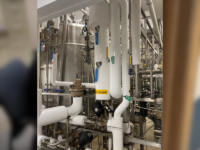Blog post by Casey Oppegard, Electrical Engineer

Whether you are developing a control system from scratch or making an addition to an existing system the use of a tag naming standard will improve development time as well as troubleshooting in the future. We have helped numerous customers develop tag naming standards. One such example is the City of Omaha for its CSO projects in order to keep uniformity across the entirety of the 20 years of the project.
- Tags using matching names between the PLC and HMI will help avoid mistakes with communication.
- Tag names create a consistency in communication between PLC and HMIs. Although Allen-Bradley already uses tag names as a link, not all manufacturers do. Some communicate using a data address. This could lead to three different pieces of information known; the PLC tag name, the HMI tag name, and the data address. In using these standards, maintenance personnel need to remember fewer tag names when troubleshooting, improving speed in which maintenance can be performed and helping to avoid delays during development and testing.
- By having a standard for Tag names, you can create names that are descriptive and informative
- Creating a standard for tag names allows you to develop a convention that works best for the customer since not every place is the same. By being able to define that each tag follows the same creation guidelines you can insure that the tags describe their function in their names. For example, having a motor on a piece of equipment in a certain area could have a name of “AREA_EQUIP_MOTOR_ON”. By just reading the tag name you can get the information of: where the equipment is located, what piece of equipment, what part of the equipment, and the function of that part. And by having these standards you could look through a tag database and easily find all motors at a facility by searching for “MOTOR”.
- Control systems can be more uniform regardless of who created them or when they are created
- Another benefit of having a written standard for naming tags is consistency. Having a standard developed, any future control system projects can reference the standard. No matter who is doing the work, internal or external, the systems will have the same format. By keeping the tag format the same, training and troubleshooting time is reduced. Uniformity in systems created by different companies but the same descriptive tag names means an individual does not have to understand multiple tag systems. This reduces the amount of documentation needed for each individual piece of equipment if there is one “master” document for tag naming standards.
While taking time up front, having tag naming standards across your facility will improve development and maintenance time as well as giving a uniformity to all future control systems.




